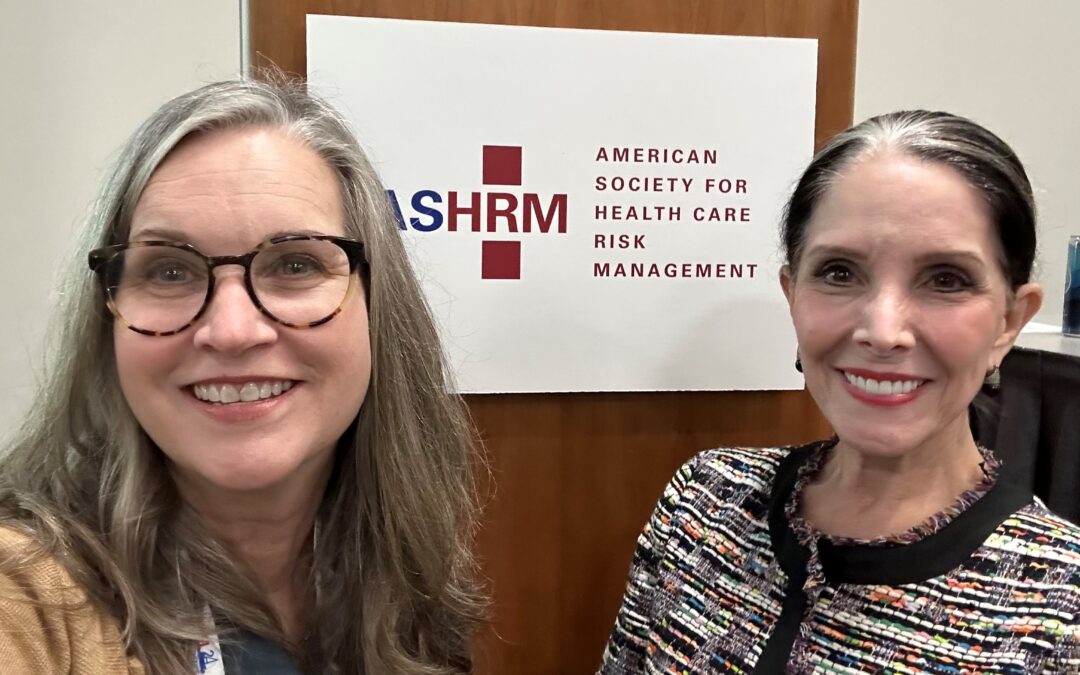I had a fantastic time in San Diego at the American Society for Healthcare Risk Management, speaking with my friend Monica Chadwick. Our presentation was called, “The X Factor: A Paradigm Shift in Mitigating Severe Pressure Ulcer/Deep Tissue Malpractice Claims.” We talked about the reasons that healthcare facilities are unfairly held liable for medically unpreventable pressure ulcers. We talked about the “inside to outside” mechanism of severe pressure ulcers and the fact that they are usually due to tissue infarctions – almost always the infarction of an artery (or vein) large enough to have a name.
There’s a story to be told about “stage 1” pressure ulcers, too – which are actually ischemia reperfusion injuries. My son developed “stage 1” pressure injuries during maxillofacial surgery which were caused by the wedges placed at the back of his heels intended to prevent pressure ulcers on the feet. The wedges themselves occluded the arterial flow to the left posterior calcaneal artery and the right lateral malleolar artery. He had NO direct pressure over these areas. What he had was an ischemia reperfusion (IR) injury caused by arterial occlusion – with the underlying problem being the extremely low blood pressure maintained during maxillofacial surgery. His case proved that LOCAL pressure may not be the problem with “stage 1” pressure injuries. In fact, I had to remove the foam pad on his heels to see the ischemia reperfusion injury. Foam pads can’t prevent ischemia reperfusion injures caused by an occlusion of arterial flow proximal to (and distant from) the visible tissue injury. In the case of deep tissue injuries (DTIs), the tissue actually infarcts (dies), and a stage 4 ulceration evolves (rather than progresses) as a result. That’s why stage 4 ulcers happen from the inside out.
The “X” factor that is being overlooked is hypotension. DTIs – which evolve into Stage 4 pressure ulcers – are due to the infarction of the three-dimensional block of tissue served by a named artery/vein. While “pressure” may be involved, in the case of DTI/Stage 4 pressure ulcers, it is not “local” pressure at the capillary level. The problem occurs proximal to the visible area of injury and involves the artery/vein that supplies the block of tissue. And the problem is not limited to the skin – it involves the muscle, tendon and subcutaneous tissue underlying the skin. The skin is the last tissue to die. Because it’s an infarction, we can establish objective thresholds for “medically unpreventable” pressure ulcers. That’s where research needs to focus now.
Thank you to the American Society for Healthcare Risk Management for getting the conversation about pressure ulcers/injuries on the right track! I am happy to present to any Risk Management group that would like to understand the “inside out” mechanism of DTIs/stage 4 pressure ulcers, and what the next generation of risk mitigation strategies needs to look like.
Find more useful information here:

Dr. Fife is a world renowned wound care physician dedicated to improving patient outcomes through quality driven care. Please visit my blog at CarolineFifeMD.com and my Youtube channel at https://www.youtube.com/c/carolinefifemd/videos
The opinions, comments, and content expressed or implied in my statements are solely my own and do not necessarily reflect the position or views of Intellicure or any of the boards on which I serve.




Excellent work in the area of pressure injuries. When you take a step back it makes sense that DTIs evolve into stage 4 pressure injuries. Wound love to see your reference articles. Thank you for your hard work and efforts.
I had a patient, retired Family Physician, with ESRD on HD who was subsequently diagnosed with PAD who presented to our wound care clinic, with bilateral CLASSIC heel DTI pressure injuries. Standard scanned wound care workup ensued with intermittent deterioration. And with NO PRESSURE issues ongoing. We had aggressively and diligently pursued off-loading. He was 100% compliant. Yet, the pattern of intermittently improving then worsening persisted, the wound ultimately entering chronic category. His delayed arterial studies returned. PAD. Bilateral. But only mild to moderate in potential culprit vessels. A little more investigative work Demonstrated fairly frequent hypotensive episodes during dialysis, and a deeper dive, showed a temple relationship between his heel injury, and hypotension with systolic BP reported in the 80 range.
So, yet more PROOF, DTI has an ischemic origin!! Low flow! The problem is ironically, but tragically, LOW perfusion pressure , not HIGH mechanical pressure!!
How many billions of dollars in penalties have been levied against hospitals????? Not to mention the mislabeling conjured up pictures of poor nursing care. The hardest working people in the hospital are unjustifiably charged with NOT doing their jobs!! And we all end up paying for that!